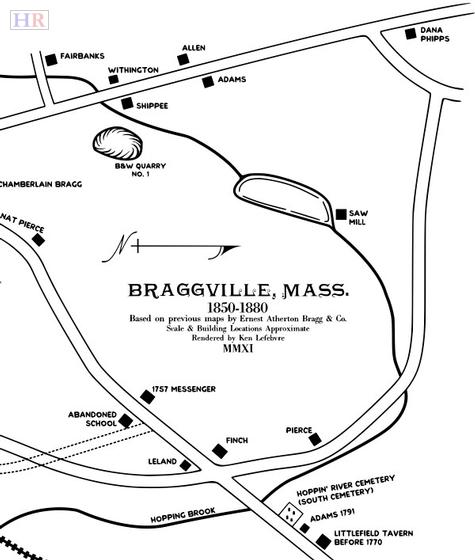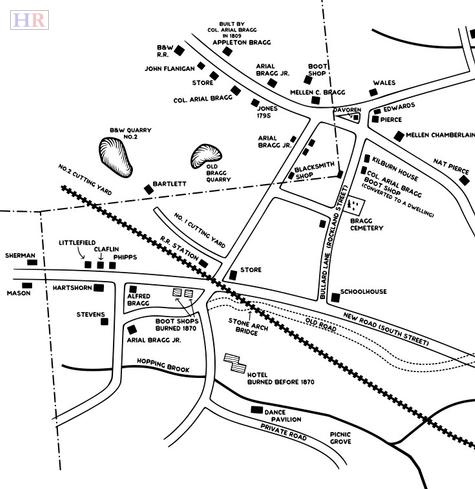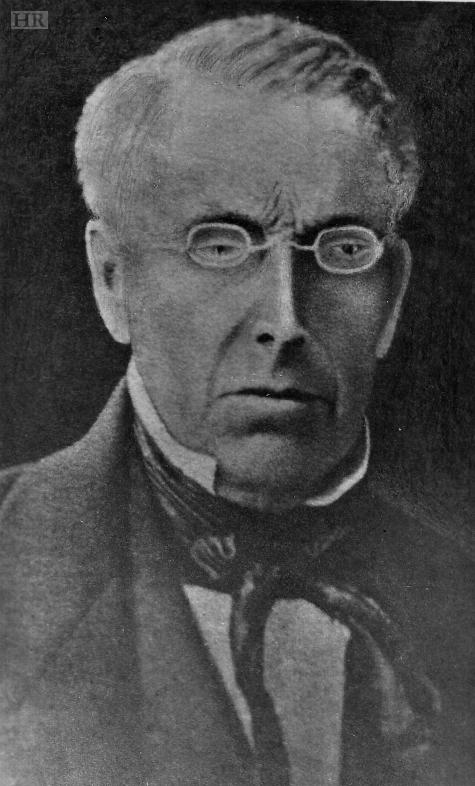Braggville: Portrait of a Community's Past: Part 1



Should you find yourself glancing at a map of Holliston, whether it be in Google Maps or on a GPS, or on the increasingly rare occasion that you have an atlas -- you might notice the town's name isn't alone, with its boundaries shared by a several others. You might see written across most maps names like "Strawberry Hill" or "Gooch Corners", "Metcalf", and "Mudville", and towards the southwest corner, an oddly placed settlement known as "Braggville".
These days, relatively few people acknowledge the name "Braggville" (correct me if I'm wrong), as it remains only titular in nature. It still adorns several maps and the signs of a local painting company, but few places otherwise. In another time however, the name "Braggville" once had as much resonance behind it as Holliston does today. Sadly a series of misfortunes can be attributed to the stark difference between the two names today. Let us turn back the clocks then, for the echoes that still speak.

Painting of Arial Bragg, founder of Braggville. Date unknown.
It was in 1793 that Colonel Arial Bragg (pronounced Ar-EYE-el), the community's namesake and founder, returned to Holliston a free man. He was many occupations throughout his life -- a shoe manufacturer, farmer, soldier for 29 years, a state representative and senator. However, before becoming a noted figure in the village, the town and the state, Arial faced a many adversities along the way. For nearly his entire existence up to 1793, he had lived a life of penury and squalor. His father, an adamant patriot, enlisted in a militia during the American Revolution while Arial was still very young, leaving his mother behind to raise him and his siblings and tend to the family's farm. The latter proved impossible however, as colonists loyal to the British, the "Tories", in bitterness and malignancy, destroyed the family's fields, letting their swine eat what was left of the crops. His mother was far too weak and poor to look after her children, and her husband never returned. It seems, he wasn't spared in the war. Around 1780 she would send her second born son, Arial, to live with Daniel Fould of Wrentham until his uncle, Alexander Bragg, would pick him up at a later time. Soon after his uncle's arrival, it was decided by the board of Wrentham selectmen that Arial, being an impoverished child, should serve an indentured servitude to his uncle until the age of 16.
The contract binding the two explains this best:
The "selectmen of the Town of Wrentham…do put and place [Arial] Royal Bragg, son of Royal Bragg, a poor child, as an apprentice to Alexander Bragg of Wrentham aforesaid…to serve, abide and remain, until he shall arrive at the age of sixteen years, until which time, or term, his master he shall faithfully serve, his secrets keep close, and his lawful commands gladly do and obey…And the said master, doth hereby promise…[to] provide for the said apprentice, good wholesome meat, drink, washing, lodging, suitable apparel, and all other things necessary, both in sickness and in health….and to teach and instruct said apprentice in husbandry business, and also to teach or cause him to be taught in reading, writing and Arithmetic, so much as shall be necessary to him…[he shall be] dismiss[ed] with two good suits of linen for all parts, one suit for Sabbath days, the other for working days."
Initially Arial received good treatment from his uncle with all of the terms of their contract filled. However, as soon as he and his master moved out of the house shared by his mother and grandfather, this all changed almost overnight. His uncle purchased land in Holliston on March 8th, 1785, and from that day forth, despite his uncle's relative wealth and well-being, Arial would literally grow up with only one shirt at a time. He was kept past his contract, having not received the payments agreed in its terms, and was kept by his uncle (whom he bitterly referred to as his "pretend master") as an indentured servant to the age of 18. Had it not been for his own wit and complaints he might have been kept until the age of 22, as his uncle often insisted. After a bout with smallpox and the paying of his debts, Arial returned to Holliston with ten dollars (about $150 today), the clothes on his back and his rights restored.
After settling in and getting his affairs in order, Bragg began a career for which Holliston would later be famous -- the craft of shoemaking. He learned the trade in part from his former master and otherwise from Asa Norcross, whose family first took him in at his arrival and who would later work in his shops. At this time, footwear wasn't fitted for a left or a right foot, and most boots and shoes were either tailored individually by cobblers or bought in barrel loads of cheaper British imports. Arial's initial lot of 22 brogan shoes was made in 1793, using a borrowed horse and capital to start his venture. He was successful, having sold the entire lot in Providence not long after their completion. One of his descendants, Ernest A. Bragg, an amateur historian and geologist, to whom we owe much of the community's history, states in one of his books that he believed Arial's was the first strictly wholesale boot and shoe business not only in Holliston but in the entire United States. However, whether or not this historic claim can be verified by another source remains to be seen. By the end of 1805 Arial Bragg had already built his first shop, and with each additional year from his start in 1793 had hired an additional man to his workforce. In 1809 he constructed a new residence for himself and his children along with enough room for twelve journeymen shoe workers. Much of his help were skilled bachelors who would travel across New England looking for work where the opportunity presented itself. Once enough shoes were made for a shipment, Bragg, accompanied by Norcross or one of his other workers, would take them by carriage into Boston or Providence, even selling them as far away as Baltimore at one point. He and his second wife (his first dying at the age of 19) went on to have many children. With his success he began to gradually buy land from many of his neighboring farmers in southwestern Holliston, accumulating over 175 acres between 1803 and 1830. Such were the beginnings of the village of Braggville.
Years passed and the shoe industry grew both in Braggville as well as in the respective Holliston and Milford downtown centers. Soon it became apparent that more efficient means were needed for transportation in the town's budding economy. Carriages simply were too time-consuming a method of moving so many goods. The answer soon arrived with the construction of the Milford branch of the Boston & Worcester Railroad in the late 1840s. Today the railroad is best remembered by the Bogastow Brook Viaduct on Woodland Street, Casey's Crossing station, and the bridge on Arch Street. Unbeknownst to many, the train route used to stop at a similar station before Milford, further to the south, in the center of Braggville.
Before the construction of the station, tickets were sold in a small shop across from the street from the tracks. Until the end of the Civil War, the railroad company also maintained its own offices and a granite cutting yards there. These cutting yards were closed sometime after the war. Long after these were closed and the railroad was completed, another variety of granite was discovered in the village with a unique texture and pinkish tint. Though best known as "Milford pink granite", the granite mined from Braggville's quarries in the 1870's would be used extensively in the original Worcester Central Station (only partly extent today), Springfield's Main Street arch (near the Peter I. Picknelly/Peter Pan Bus Station), other markers and infrastructure of the Boston & Albany railroad. Milford pink was used in several of prominent American architect H.H. Richardson's works, including the Glessner House in Chicago, Old Colony Railroad Station of North Easton , Allegheny County Courthouse, and the old Allegheny County Jail.

Boston & Worcester Cutting Yard
Although not of the pink variety, much of Braggville's earlier excavated granite was used in Holliston's bridges, including two in Braggville similar to the one on Arch street. A smaller one crossing the Hopping Brook may still be seen today while the other, now almost completely covered in dirt, crossed what was once the old South Street. Sometime in the late 1850s or early 1860s, the town of Holliston built the new South Street as it stands today. At the time this proved very controversial however as the old road had run along the crest of high land, whereas the new one cut directly through one farmer's best tillage land. The farmer was so upset by this that he immediately sold out and moved elsewhere.
South Street Intersection. With the schoolhouse, stores, post office and railroad station long gone, nobody would suspect that this neighborhood intersection was once the downtown hub of the shoe industry.
Soon after the farmer's departure, Arial Bragg Jr. purchased the property and planted lines of maple trees on South and Rockland street, many of which may still be seen today.
Special thanks to Hester Chesmore, librarian of the Holliston Historical Society for all her help and the historic photographs, and also to the interlibrary loan staff of the University of Massachusetts W.E.B. DuBois Library.
Ken Lefebvre, an alumnus of Holliston High School (Class of 2009), is currently enrolled as an undergraduate student at the University of Massachusetts Amherst. Although majoring in Environmental Science, he often finds much interest in the history of Holliston, Massachusetts and New England as a whole, particularly in its obscure details.
Sadly, the maple tree pictured here on Rockland Street fell during tropical storm Irene. Fortunately, it just missed the owner's home!
Sheri O'Brien | 2011-09-05 22:13:09
I too appreciate the effort, Ken. The link to Page 2 seems to be missing (pasted below) though there's a lot of overlap with page 1. It will help us learn about our neighborhood and give us some stories for our daughter. http://www.hollistonreporter.com/article/5640/Braggville-Portrait-of-a-Community-s-Past-Part-2.html
Brian Ream | 2011-08-22 13:36:09
Thank you all for the positive feedback on the article, it's far more than I ever expected. Where to begin-- Joanne- thanks for the encouragement, I might just have to take you up on those offers sometime. The year that my family moved here it was the end of the school, didn't no anybody around here, so I spent most of that summer just reading in the library. There I found some on books on the town and the rest is history (sorry for the pun). I actually met you about 5-6 years back when I bought a copy of your book at (I think it was) the society's harvest festival. You gave me and my family a brief tour of library room there and not long after I became a member. Of course I never actually went back, or at least until a couple weeks ago. As I'm sure you've already noticed, I copied the map label for label, exactly as it was, just evening out the spacing so readers would better recognize it… but what a strange, unsettling label. I wonder if it became so known of an incident that that's all people would call it, the "Finch" house. Stranger though that the maps never mention the actual occupants. Holliston history is great, for such a sleepy town today it seems to have a wealth of history in agriculture, industry, education, and otherwise just bizarre little incidents not unlike this one. It might be a little while with all the college work waiting to be done, but I'll be sure to write more for the reporter (and maybe elsewhere) again. Paul- thank you sir, if you really think it'd be doable, I'll definitely consider it. May not be for while though, have a lot on my plate for this fall. David- You're absolutely welcome! As I figuratively dug more of this history up, it only became easier to keep going. For a little train stop/postal village, that side of town has a long past still waiting to be uncovered. I didn't realize that the foundation was still there, that's fantastic. Unfortunately there are almost no photos of Braggville in the books I found and
Ken Lefebvre | 2011-08-18 08:08:50
Yes, Michelle, Ido bus tours rather frequently - just did one a week ago for a group of people on a "mystery tour" and we had a great time. I bet you remember the League of Women Voters bus tours that we did decades ago. I've learned a lot more about town history since those days, and I'm always up for either a bus tour, or, a walk in the woods - since I am on the Town Forest Committee - and the Town Forest is a fascinating place if you haven't discovered it yet - and that goes for anyone else living in Holliston, there's many places in town hiding great history - in plain view! Joanne Hulbert
Joanne Hulbert | 2011-08-17 20:24:58
Great article Ken! After reading Joanne's book (and this article), I will always remember Arial Bragg as being one of the most interesting people in this town's history. I'm glad it was made mention on here that Braggville was once a VERY busy end of town. Joanne, I do remember that story very well about the corner of Washington and Courtland St.
James Read | 2011-08-16 21:26:53
Ken: while I'm thinking of it, come back sometime and I'll show you a rock where the quarrymen did some test-drilling, by hand, and another rock on which one of the workers, who evidently couldn't get enough of his job, carved a blazing sun during a few of his idle moments.
David Bastille | 2011-08-16 21:22:18
Thank you for a well-researched and well-written article. The past in Braggville has been buried, but only somewhat; like the stone arch railroad bridge, it keeps coming up to the surface. My house sits where the school used to be, and some of the old foundation is still there. Arial Bragg's sugar maple, above, has been a reliable source for sap for my family for many winters. Were any photos ever taken of the schoolhouse?
David Bastille | 2011-08-16 21:12:44
Ken, You should consider giving a talk at the Historical Society about Braggville - or any other topic related to Holliston. I'm sure you would do a great job.
Paul Saulnier | 2011-08-16 16:28:15
Joanne - A long time ago you organized a bus tour through town. We drove down random streets and you told us stories about the houses and neighborhoods. It was so long ago that I'm not sure of the specifics. It may have been during Celebrate Holliston. It was wonderful. Would you consider doing something like that again?
Michelle Zeamer | 2011-08-16 13:58:36
Ken, Great article on Braggville! I am thrilled to see someone else who has an interest in Holliston's history. There's so much out there that can be researched and studied, I know that so well, having been at it for many years. Several of our predecessors, such as Dan Chase back in the 1930s, studied areas that I would not have had enough time to pursue, so welcome aboard and jumping, the pool of undiscovered town history is awaiting more researchers! The map of Braggville has always intrigued me for the history it tells. One interesting note is, take a look at the corner of present-day Washington and Courtland Streets where the mark notes 'Finch' as the occupant. A little bit of crime history: I have wondered why 'Finch' is designated for the house, as Alvin Finch was a boarder there with the Reeve family. In November of 1861, newspaper articles of the time reported he went berserk and killed Mrs. Reeves and her daughter. Yes, Holliston's first double murder - that I know of - always keep your historical options open!. Why his name is on the map for perpetuity is one of those minor local history conundrums- little bits of town history of which there are many that continue to intrigue and inspire me to look for more. (BTW, the Reeves house burned during the fracas, not to worry present residents!) So, Ken, keep it coming, and if you want any local history advice, or a free tour, let me know. Joanne
Joanne Hulbert | 2011-08-16 10:03:29
Great job, Ken. I learned a lot. I used to live on SOuth St. and enjoyed getting to know the ancestral characters of the neighborhood. Thanks for your effort and clear writing.
Mary | 2011-08-16 08:03:03